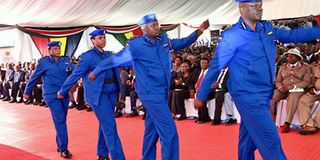How new reforms will affect police officers

Police officers display their new uniforms during the National Policing Conference at the Kenya School of Government on September 13, 2018. PHOTO | DENNIS ONSONGO | NATION MEDIA GROUP
What you need to know:
- The police will receive orders from a regional police commander (RPC), a county police commander (CPC), a sub-county police commander (SPC), an officer commanding police station (OCS) who will also be known as a ward commander.
- The government says it will have a unified, effective and efficient police service because the commands will flow faster and do not have to pass through many levels.
The changes in the command structure of the National Police Service will strip some senior police officers of their powers at the regional, county and station level.
Initially, the three arms of the National Police Service, the Kenya Police Service (KPS), the Administration Police Service (APS) and the Directorate of Criminal Investigations (DCI), each had independent commanders at every level.
But with the new changes announced by President Uhuru Kenyatta yesterday, regionals commanders of APS, KPS, DCI will no longer exist.
Other posts that have scrapped are county commanders of KPS, APS, DCI, sub-county commanders of APS and DCI.
KPS officer commanding police divisions (OCPDs), APs commanders for district and wards will also no longer exist.
REDEPLOYMENT
The police will receive orders from a regional police commander (RPC), a county police commander (CPC), a sub-county police commander (SPC), an officer commanding police station (OCS) who will also be known as a ward commander.
Interior Cabinet Secretary Fred Matiang'i, who denied claims that the APS was being scrapped, said all the officers holding previous positions will be redeployed or assigned other duties as staff officers.
“The officers will maintain their ranks and will be deployed to perform other duties within the National Police Service,” Dr Matiang'i said.
In the new changes, the police geographic and operational boundaries will be aligned with current administrative boundaries to deliver a unified command organised removing the current police divisions, headed by the OCPD.
The OCPD commands the police divisions, which comprises of several police stations under the command of an OCS.
TRAINING
Under the new structure, the OCS will be in charge of the police station and its posts and patrol bases.
Dr Matiang'i said police officers will be trained afresh to address the new expectations.
Only officers who were among the last two cohorts to graduate from the police training colleges will be spared of the refresher trainings, because they are being trained under the new police curriculum.
With the new changes, the government says it will have a unified, effective and efficient police service because the commands will flow faster and do not have to pass through many levels.
“This also consolidates the resources that we have because the cars that were used by the commanders at different levels will now be available for patrols and other operations,” Dr Matiang'í said.
While announcing the radical changes, President Kenyatta said the police force will grant Kenya “a new service”.
Besides, the command structure, the changes also touch on uniform, housing and training.





